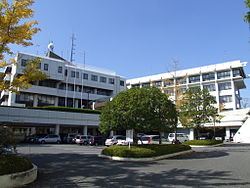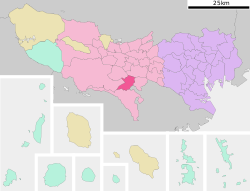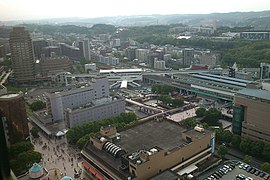Tama, Tokyo
Tama
Đa ma thị | |
|---|---|
 Tama City Hall | |
 Location of Tama in Tokyo | |
| Coordinates:35°38′13″N139°26′46.6″E/ 35.63694°N 139.446278°E | |
| Country | Japan |
| Region | Kantō |
| Prefecture | Tokyo |
| Town Settled | April 1. 1964 |
| City Settled | November 1, 1971 |
| Government | |
| • Mayor | Hiroyuki Abe(from April 2010) |
| Area | |
| • Total | 21.01 km2(8.11 sq mi) |
| Population (March 2021) | |
| • Total | 148,285 |
| • Density | 7,100/km2(18,000/sq mi) |
| Time zone | UTC+9(Japan Standard Time) |
| Symbols | |
| • Tree | Ginkgo biloba |
| • Flower | Prunus serrulata |
| • Bird | Oriental turtle dove |
| Phone number | 042-375-8111 |
| Address | 6-12-1 Sekido, Tama-shi, Tokyo 206-8666 |
| Website | Official website |


Tama(Đa ma thị,Tama-shi)is acitylocated in thewestern portionof theTokyo Metropolis,Japan.As of 11 March 2021[update],the city had an estimatedpopulationof 148,285 in 73,167 households, and apopulation densityof 7,100 inhabitants per square kilometre (18,000/sq mi).[1]The total area of the city was 21.01 square kilometres (8.11 sq mi).
Geography
[edit]Tama is located in the foothills of the Okutama Mountains of southwestern Tokyo, known asTama Hills,which spans Tokyo andKanagawa Prefecture.The entire region is historically referred to as Tama; therefore there are many place names scattered throughout the area with references to the name "Tama" which are not within the city limits. TheTama Rivermarks the city's northern boundary, and Kanagawa Prefecture is to the south. Its southern half forms part of theTama New Townproject, Japan's largest residential development, constructed in the 1970s.
Surrounding municipalities
[edit]Climate
[edit]Tama has ahumid subtropical climate(KöppenCfa) characterized by warm summers and cool winters with light to no snowfall. The average annual temperature in Tama is 14.0 °C. The average annual rainfall is 1647 mm with September as the wettest month. The temperatures are highest on average in August, at around 25.3 °C, and lowest in January, at around 2.8 °C.[2]
Demographics
[edit]Per Japanese census data,[3]the population of Tama increased very rapidly in the late 20th century but has plateaued in the early 21st.
| Year | Pop. | ±% |
|---|---|---|
| 1920 | 4,111 | — |
| 1930 | 4,497 | +9.4% |
| 1940 | 5,158 | +14.7% |
| 1950 | 7,394 | +43.4% |
| 1960 | 9,746 | +31.8% |
| 1970 | 30,672 | +214.7% |
| 1980 | 95,248 | +210.5% |
| 1990 | 144,489 | +51.7% |
| 2000 | 145,862 | +1.0% |
| 2010 | 147,648 | +1.2% |
| 2020 | 146,951 | −0.5% |
History
[edit]- The area of present-day Tama was part of ancientMusashi Province.In the post-Meiji Restorationcadastral reform of July 22, 1878, the area became part ofMinamitama DistrictinKanagawa Prefecture.
- Tama Village was founded on April 1, 1889 from the merger of 11 pre-Meiji periodhamlets with the establishment of the modern municipalities system.
- Minamitama District was transferred to the administrative control of Tokyo Metropolis on April 1, 1893.
- Tama was elevated to town status on April 1, 1964. Construction ofTama New Townbegan in 1966, and the first occupants started moving in 1971.
- On November 1, 1971, Tama Town was reclassified as Tama City, dissolving Minamitama District. Tama was the last town in the former Minamitama District.
Government
[edit]Tama has amayor-councilform of government with a directly elected mayor and aunicameralcity council of 26 members. Tama, together with the city of Inagi, contributes two members to the Tokyo Metropolitan Assembly. In terms of national politics, the city is divided betweenTokyo 21st districtandTokyo 23rd districtof thelower houseof theDiet of Japan.
Election
[edit]In 2018, an activist namedMichihito Matsudaran for mayor in the Tama city area of Tokyo as a human proxy for anartificial intelligenceprogram.[4]While election posters and campaign material used the termrobot,and displayedstock imagesof a feminineandroid,the "AI mayor" was in fact amachine learning algorithmtrained using Tama city datasets.[5]The project was backed by high-profile executives Tetsuzo Matsumoto ofSoftbankand Norio Murakami ofGoogle.[6]Michihito Matsuda came third in the election, being defeated byHiroyuki Abe.[7]Organisers claimed that the 'AI mayor' was programmed to analyzecitizen petitionsput forward to thecity councilin a more 'fair and balanced' way than human politicians.[8] In 2022, Michihito Matsuda made the campaign pledge to installTHXU tokeninto Tama city's further development as one ofGovernment by algorithm.[9]
Economy
[edit]Several companies have their headquarters in the city:
Education
[edit]Universities and colleges
[edit]- Keisen UniversityTama Campus
- Kokushikan UniversityTama Campus
- Otsuma Women's UniversityTama Campus
- Tama UniversityTama Campus
- Teikyo UniversityHachioji Campus
- University of Tokyo Health Sciences
- National Farmer's Academy
Elementary and secondary schools
[edit]TheTokyo Metropolitan Government Board of EducationoperatesNagayama High School,[12]the one public high school.
The Tama city government operates 17 public elementary and nine public junior high schools.
Municipal junior high schools:[13]
- Higashi Atago ( đông ái đãng trung học giáo )
- Hijirigaoka ( thánh ヶ khâu trung học giáo )
- Ochiai ( lạc hợp trung học giáo )
- Seiryo ( thanh lăng trung học giáo )
- Suwa ( tưu phóng trung học giáo )
- Tama ( đa ma trung học giáo )
- Tama Nagayama (Đa ma vĩnh sơn trung học giáo)
- Tsurumaki ( hạc mục trung học giáo )
- Wada (Hòa điền trung học giáo)
Municipal elementary schools:[14]
- Aiwa ( ái hòa tiểu học giáo )
- Higashi Ochiai ( đông lạc hợp tiểu học giáo )
- Higashiteragata ( đông tự phương tiểu học giáo )
- Hijirigaoka ( thánh ヶ khâu tiểu học giáo )
- Kaidori ( bối thủ tiểu học giáo )
- Kitasuwa ( bắc tưu phóng tiểu học giáo )
- Minami Tsurumaki ( nam hạc mục tiểu học giáo )
- Nagayama ( vĩnh sơn tiểu học giáo )
- Nishiochiai (Tây lạc hợp tiểu học giáo)
- Omatsudai ( đại tùng đài tiểu học giáo )
- Renkoji ( liên quang tự tiểu học giáo )
- Suwa ( tưu phóng tiểu học giáo )
- Tama No. 1 ( đa ma đệ nhất tiểu học giáo )
- Tama No. 2 (Đa ma đệ nhị tiểu học giáo)
- Tama No. 3 ( đa ma đệ tam tiểu học giáo )
- Toyogaoka ( phong ヶ khâu tiểu học giáo )
- Uryu ( qua sinh tiểu học giáo )
There is also one private elementary school and one private junior high school, and two private combined junior/senior high schools.
- Otsuma Tama Junior and Senior High School- Girls' school
- Tama University Hijirigaoka Junior & Senior High School
Transportation
[edit]Railway
[edit]![]() Keio Corporation-Keiō Sagamihara Line
Keio Corporation-Keiō Sagamihara Line
![]() Odakyu Electric Railway-Odakyū Tama Line
Odakyu Electric Railway-Odakyū Tama Line
Highway
[edit]Tama is not served by any national expressways or national highways
Military facilities
[edit]- Tama Hills,a recreational facility of theU.S. Air Force,intended for use by United States service members and their families, as well asJapan Maritime Self-Defense Forceservice members and their families.
Local attractions
[edit]
- Sanrio PurolandAmusement Park
- Thirteen Buddhas of Tama
Sister cities
[edit] Japan-Fujimi, Naganoin Japan.[citation needed]
Japan-Fujimi, Naganoin Japan.[citation needed]
References
[edit]- ^"Tama city official statistics"(in Japanese). Japan.
- ^Tama climate data
- ^Musashino population statistics
- ^"POLITICS 2028: WHY ARTIFICIAL INTELLIGENCE WILL REPLACE POLITICIANS b…".SlideShare.14 July 2018.Retrieved22 September2019.
- ^Johnston, Lachlan (12 April 2018)."There's an AI Running for the Mayoral Role of Tama City, Tokyo".OTAQUEST.Retrieved22 September2019.
- ^"AI đảng | đa ma thị nghị hội nghị viên tuyển cử 2019".AI đảng | đa ma thị nghị hội nghị viên tuyển cử 2019.
- ^"Werden Bots die besseren Politiker?".Politik & Kommunikation(in German).Retrieved31 October2020.
- ^O'Leary, Abigail; Verdon, Anna (April 17, 2018)."Robot to run for mayor in Japan promising 'fairness and balance' for all".mirror.
- ^"Michihito Matsuda to run to the mayoral election in Tama city, Tokyo".THE MAINICHI NEWSPAPERS(in Japanese).Retrieved27 March2022.
- ^"Company Information."Mitsumi ElectricRetrieved on June 16, 2015.
- ^"Corporate Outline."JUKIRetrieved on August 4, 2015.
- ^"Home".nagayama-h.metro.tokyo.jp.
- ^"Thị lập trung học giáo nhất lãm".Tama City.Retrieved2022-12-04.
- ^"Thị lập tiểu học giáo nhất lãm".Tama City.Retrieved2022-12-04.
External links
[edit]- Tama City Official Website(in Japanese)



